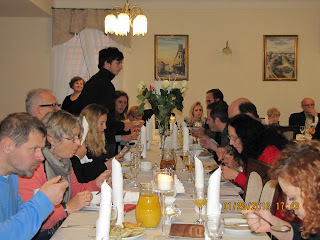In 2002, during my first visit to Lubaczow, Bogdan drove me to Belzec. It was a confusing visit.
When we got there, Bogdan showed me a map that assumably showed the extermination camp of Belzec. Looking at the map and comparing the surroundings, there wasn't much to explain how close to half a million persons were murdered there between March 1942 and June 1943.
Close to the map was a building that had been part of the camp, and up a little hill was a contruction with some bones around it. We walked up the hill and walked around the forest.
it seemed unreal to think what had happened here.
It was difficult to imagine where the borders of this hell had been.
Some relatives of those I know were murdered in the Belzec camp.
How could I explain to them what Belzec looked like?
Several years later, Bogdan brought me back to Belzec, and a so much had happened.
Belzec had become a memorial, after years of research.
Bogdan and I walked around a path listing the places the victims had once lived, including Lubaczow.
We walked through a symbolic "death row" leading up to a wall with given names of victims. The museum is trying to document as many as possible of the victims - an ongoing project.
Then we visited the memorial museum where texts in English, Polish and Hebrew, presented the history of the Belzec camp.
Here is the website for the Belzec Memorial
https://www.belzec.eu/en
Here is the Wikipedia entry for Belzec extermination camp
https://en.wikipedia.org/wiki/Belzec_extermination_camp
Belzec's history is so terrible, but one local family, Maciej and Cecylia Brogowski, did an incredibly act of courage - they saved a little Jewish girl named Irena. After I had located this family, Bogdan was gratious to bring me to visit that family. His patience, his warm attitude to the family members - it is a good way to remember Bogdan.
During one of my visits to Lubaczow, Bogdan was willing to bring me to the Brogowski family in Belzec.
Later, on June 11, 2006, Maciej and Cecylia Brogowski were recognized by Yad Vashem as Righteous Among the Nations.
https://collections.yadvashem.org/en/righteous/5684693
For me, Bogdan was the person who was by my side both during the visits to Belzec the extermination camp and to that emotional visit at the home of the Brogowiski family.








.JPG)


.JPG)


%20(1).jpg)





